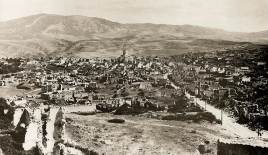Shusha massacre
Wednesday, March 23, 2022
The Shusha massacre or Shushi massacre, also known as the Shusha pogrom, was the mass killing of the Armenian population of Shusha and the destruction of the Armenian half of the city in 1920.
The massacre took place between 22 and 26 March 1920, and had as its background a conflict over competing claims of ownership of the region by Armenia and Azerbaijan.
At the end of the First World War, the ownership of the territory of Nagorno-Karabagh was disputed between the newly founded states of the Democratic Republic of Armenia and the Azerbaijan Democratic Republic. Shusha – the territory's largest settlement, its capital, and with a mixed population consisting mostly of ethnic Armenians and Azerbaijanis – found themselves at the centre of the dispute.
The government of Azerbaijan proclaimed in Baku the annexation of the disputed territory and, on January 15, 1919, appointed Khosrov bek Sultanov, as governor-general of Karabagh. The United Kingdom had a small detachment of troops stationed in Shusha and acceded to Sultanov's appointment as provisional governor, but insisted that a final decision on the territory's ownership should be decided only at a future peace conference.
In response to Sultanov's appointment, the General Assembly of the Armenians of Karabagh (Armenian National Council of Karabagh), meeting in Shusha on February 19, "rejected with legitimate indignation all pretence of Azerbaijan with regard to Armenian Karabagh, which said Assembly has declared an integral part of Armenia".
On April 23, 1919, the National Council of Karabagh met again in Shusha and again rejected Azerbaijan's claim of sovereignty, insisting on their right of self-determination. After this, a local Azerbaijani detachment encircled the Armenian quarters of Shusha, demanding the inhabitants to surrender the fortress. Shots were fired, but when the British mediated, Armenians agreed to surrender to them instead.
On the 4 and 5 June 1919, armed clashes occurred in Shusha between the two communities and Sultanov began a blockade of the town's Armenian quarters. American nurses working in Shusha for Near East Relief wrote of a massacre "by Tartars of 700 of the Christian inhabitants of the town". A cease-fire was quickly organised after the Armenian side agreed to Sultanov's condition that members of the Armenian National Council leave the town. However, a new wave of violence then swept through neighbouring Armenian-populated villages: in mid-June Azerbaijani mounted "irregulars", about 2,000 strong, attacked, looted and burnt a large Armenian village, Khaibalikend, just outside Shusha, and approximately 600 Armenians lay dead.
The seventh Congress of the Armenians of Karabagh was convened in Shusha on 13 August 1919. It concluded with the agreement of 22 August, according to which Nagorno-Karabagh would consider itself to be provisionally within the borders of the Republic of Azerbaijan until its final status was decided at the Peace Conference in Paris.
On 19 February 1920 Sultanov issued a demand that the Armenian National Council of Karabagh "urgently to solve the question of the final incorporation of Karabagh into Azerbaijan". The Council, at their eighth congress held from 23 February to 4 March, responded that Azerbaijan's demand violated the terms of the 22nd August provisional agreement and warned that "repetition of the events will compel the Armenians of Nagorno-Karabagh to turn to appropriate means for defence". Armenians of Karabakh prepared a revolt against Azerbaijani authority.
Revolt
According to Richard Hovannisian, the failure at Khankendi sealed the doom of Shusha. "As planned, the Varanda militia entered Shusha on the evening of March 22, supposedly to receive its pay and to felicitate Governor-General Sultanov on the occasion of Novruz Bairam. That same night, about 100 armed men led by Nerses Azbekian slipped into the city to disarm the Azerbaijani garrison in the Armenian quarter. But everything went wrong. The Varanda militiamen spent most of the night eating and drinking and were late in taking up their assigned positions, whereas Azbekian's detachment, failing to link up with the militia, began firing on the Azerbaijani fort from afar, awakening the troops and sending them scurrying to arms. It was only then that the Varanda militiamen were roused and began seizing Azerbaijani officers quartered in Armenian homes. The confusion on both sides continued until dawn, when the Azerbaijanis learned that their garrison at Khankend had held and, heartened, began to spread out into the Armenian quarter. The fighting took the Armenians of Shusha by surprise. Several thousand fled under cover of the dense fog by way of Karintak into the Varanda countryside."
Audrey L. Altstadt writes, referring to a British correspondent in Baku, that representatives of Allied Powers in the region decided that the police of Karabakh should be made up of equal numbers of Armenians and Azerbaijanis; however, in late March 1920, the Armenian half of the police murdered the Azerbaijani half during the latter's traditional Novruz Bayram holiday celebrations.
Massacre
According to Richard Hovannisian, "Azerbaijani troops, joined by the city's Azerbaijani inhabitants, turned Armenian Shusha into an inferno. From March 23 to 26, some 2,000 structures were consumed in the flames, including the churches and consistory, cultural institutions, schools, libraries, the business section and the grand homes of the merchant class. Bishop Vahan (Ter-Grigorian), long an advocate of accommodation with the Azerbaijani authorities, paid the price of retribution, as his tongue was torn out before his head was cut off and paraded through the streets on a spike. The chief of police, Avetis Ter-Ghukasian, was turned into a human torch, and many intellectuals were among the 500 Armenian victims."
The former Minister of Internal Affairs of the Azerbaijan Democratic Republic, Behbud Khan Javanshir, was assassinated during Operation Nemesis of the Armenian Revolutionary Federation for his involvement in these events.





